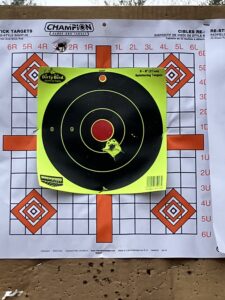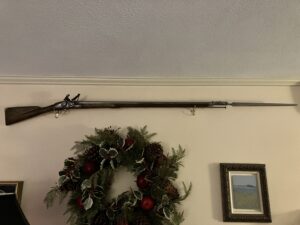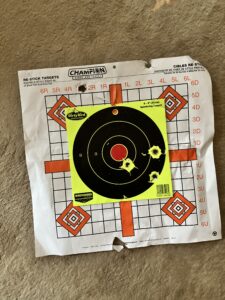Have you seen the film ‘Master and Commander’?
Do you remember the scene where there’s absolutely no wind, and they’re floating of the coast of Peru or someplace, like a dismasted raft?
That’s what my winter has been like. Only colder. Luckily I don’t think anyone is going to have to go over the side to solve this problem.
But okay, without scraping the bottom of the barrel, here’s something I’m kind of proud of.

Yeah, so? I hear you say. If you’re a person who absolutely thinks firearms are the work of very clever devils who romanced us with these lethal fire sticks… well, you’re probably right. And if you’re someone who is intimately acquainted with the things, you’re probably thinking, Big deal.
But wait until I show you what I did it with.

This is a muzzle-loading Short Land pattern Brown Bess replica. The original musket in this particular variation was introduced into the British Infantry in 1768. (British dragoons had been using it since 1740.) It has a 42″ smooth-bore barrel and is 58.5″in length overall. The bayonet adds another 18″.
I’m not sure how much this interests you, but since if it didn’t interest you at all you’ve probably already stopped reading, I’ll go on for a bit longer.
The Long Land pattern, first used as the standard infantry musket from 1722 until it was replaced with this one in 1768, had a 46″ smooth-bore barrel and was 62.5″ overall (without bayonet).
Now, I am five-foot nothing, first of all.
Second, because I have astigmatisms in both eyes, I have to squint like One-Eyed Jack to even align the end of the barrel with the target.
Thirdly, I don’t do this every weekend. I only do it when my good friend Adam invites me to go to the range with him.
And lastly, I don’t have any interest in shooting a modern weapon. There’s a challenge to shooting a muzzle-loader. People will tell you they weren’t at all accurate. Based on this, I’d say ‘accurate enough’.
Ned, the protagonist of The Private Misadventures of Nell Nobody, uses a Ferguson rifle.
This is where the novel veers off from reality, because the Ferguson was prototyped and first used during the American War for Independence. It was a breech-loading gun (it still only fired single shots, but it was faster to reload through the breech as opposed to the muzzle). It was also shorter, and lighter. But as with any prototype, there were problems with it, probably the first and most important being that the breech-loading mechanism would jam. You could still fire the weapon, but at that point you had to load it at the muzzle like a musket, which defeats the purpose. It was also expensive to build, costing four times as much as a Brown Bess, and there were only four gunsmiths who could make it.
By the time of the French Revolutionary Wars and the Napoleonic Wars (the ‘Coalition Wars’), the British Army was looking for a better alternative, which they found in the Baker rifle. That is more likely to be the gun they would have used, if they had even been using riflemen at all during the period in which the book is set; the Experimental Rifle Corps was not formed until 1800.
I have never fired a reproduction Ferguson rifle. I’d like to, just so that I could experience what my protagonist does in battle (erm, without the battle part, preferably). The other marines would have used a sea-service musket, which was essentially a Brown Bess that may or may not have had the barrel cut down a few inches more, and was made of an alloy that wouldn’t rust overnight the way an infantry musket will.

Just to prove that the second shot wasn’t a complete anomaly, here’s the target at the end of the morning.
And two of the shots didn’t actually hit the target at all.
Still, I’m impressed with myself. I think I told you somewhere else on this blog that I couldn’t hit the broad side of a bus with a cannon at 30 yards. But maybe I could. As long as it’s an empty, burned-out bus in a scrapyard somewhere.